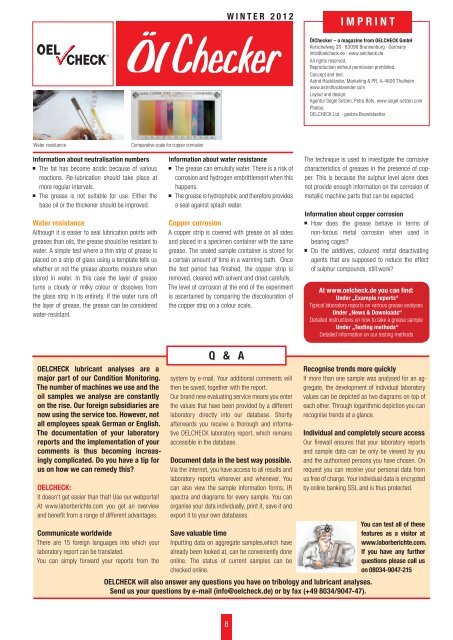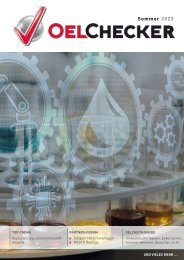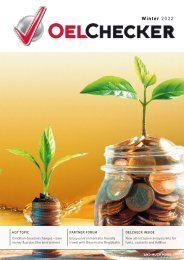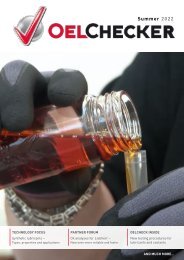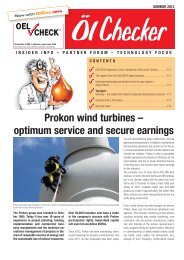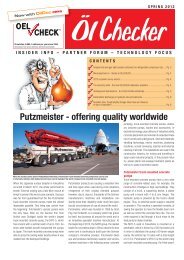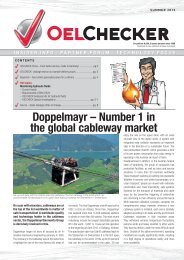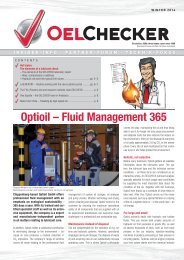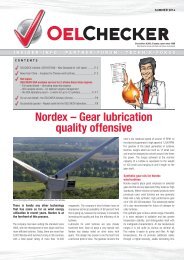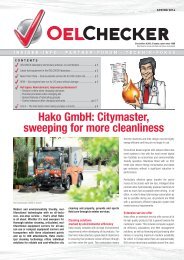OELCHECKER - Winter 2012
> OELCHECK China – Getting ready before the new laboratory opens > OELCHECK Laboratory – quicker and more accurate with a new particle counter > Hot Topics: The analysis of lubricating greases > Correct sampling > Most important analysis methods > Experience of our experienced tribologists > In demand – optimising online documentation of laboratory reports > and much more...
> OELCHECK China – Getting ready before the new laboratory opens
> OELCHECK Laboratory – quicker and more accurate with a new particle counter
> Hot Topics: The analysis of lubricating greases
> Correct sampling
> Most important analysis methods
> Experience of our experienced tribologists
> In demand – optimising online documentation of laboratory reports
> and much more...
Create successful ePaper yourself
Turn your PDF publications into a flip-book with our unique Google optimized e-Paper software.
WINTER <strong>2012</strong><br />
Imprint<br />
ÖlChecker – a magazine from OELCHECK GmbH<br />
Kerschelweg 28 · 83098 Brannenburg · Germany<br />
info@oelcheck.de · www.oelcheck.de<br />
All rights reserved.<br />
Reproduction without permission prohibited.<br />
Concept and text:<br />
Astrid Hackländer, Marketing & PR, A-4600 Thalheim<br />
www.astridhacklaender.com<br />
Layout and design:<br />
Agentur Segel Setzen, Petra Bots, www.segel-setzen.com<br />
Photos:<br />
OELCHECK Ltd. · geobra Brandstaetter<br />
Water resistance<br />
Comparative scale for copper corrosion<br />
Information about neutralisation numbers<br />
• The fat has become acidic because of various<br />
reactions. Re-lubrication should take place at<br />
more regular intervals.<br />
• The grease is not suitable for use. Either the<br />
base oil or the thickener should be improved.<br />
Water resistance<br />
Although it is easier to seal lubrication points with<br />
greases than oils, the grease should be resistant to<br />
water. A simple test where a thin strip of grease is<br />
placed on a strip of glass using a template tells us<br />
whether or not the grease absorbs moisture when<br />
stored in water. In this case the layer of grease<br />
turns a cloudy or milky colour or dissolves from<br />
the glass strip in its entirety. If the water runs off<br />
the layer of grease, the grease can be considered<br />
water-resistant.<br />
Information about water resistance<br />
• The grease can emulsify water. There is a risk of<br />
corrosion and hydrogen embrittlement when this<br />
happens.<br />
• The grease is hydrophobic and therefore provides<br />
a seal against splash water.<br />
Copper corrosion<br />
A copper strip is covered with grease on all sides<br />
and placed in a specimen container with the same<br />
grease. The sealed sample container is stored for<br />
a certain amount of time in a warming bath. Once<br />
the test period has finished, the copper strip is<br />
removed, cleaned with solvent and dried carefully.<br />
The level of corrosion at the end of the experiment<br />
is ascertained by comparing the discolouration of<br />
the copper strip on a colour scale.<br />
The technique is used to investigate the corrosive<br />
characteristics of greases in the presence of copper.<br />
This is because the sulphur level alone does<br />
not provide enough information on the corrosion of<br />
metallic machine parts that can be expected.<br />
Information about copper corrosion<br />
• How does the grease behave in terms of<br />
non-forous metal corrosion when used in<br />
bearing cages?<br />
• Do the additives, coloured metal deactivating<br />
agents that are supposed to reduce the effect<br />
of sulphur compounds, still work?<br />
At www.oelcheck.de you can find:<br />
Under „Example reports“<br />
Typical laboratory reports on various grease analyses<br />
Under „News & Downloads“<br />
Detailed instructions on how to take a grease sample<br />
Under „Testing methods“<br />
Detailed information on our testing methods<br />
OELCHECK lubricant analyses are a<br />
major part of our Condition Monitoring.<br />
The number of machines we use and the<br />
oil samples we analyse are constantly<br />
on the rise. Our foreign subsidiaries are<br />
now using the service too. However, not<br />
all employees speak German or English.<br />
The documentation of your laboratory<br />
reports and the implementation of your<br />
comments is thus becoming increasingly<br />
complicated. Do you have a tip for<br />
us on how we can remedy this?<br />
OELCHECK:<br />
It doesn‘t get easier than that! Use our webportal!<br />
At www.laborberichte.com you get an overview<br />
and benefit from a range of different advantages.<br />
Communicate worldwide<br />
There are 15 foreign languages into which your<br />
laboratory report can be translated.<br />
You can simply forward your reports from the<br />
Q & A<br />
system by e-mail. Your additional comments will<br />
then be saved, together with the report.<br />
Our brand new evaluating service means you enter<br />
the values that have been provided by a different<br />
laboratory directly into our database. Shortly<br />
afterwards you receive a thorough and informative<br />
OELCHECK laboratory report, which remains<br />
accessible in the database.<br />
Document data in the best way possible.<br />
Via the internet, you have access to all results and<br />
laboratory reports wherever and whenever. You<br />
can also view the sample information forms, IR<br />
spectra and diagrams for every sample. You can<br />
organise your data individually, print it, save it and<br />
export it to your own databases.<br />
Save valuable time<br />
Inputting data on aggregate samples,which have<br />
already been looked at, can be conveniently done<br />
online. The status of current samples can be<br />
checked online.<br />
Recognise trends more quickly<br />
If more than one sample was analysed for an aggregate,<br />
the development of individual laboratory<br />
values can be depicted as two diagrams on top of<br />
each other. Through logarithmic depiction you can<br />
recognise trends at a glance.<br />
Individual and completely secure access<br />
Our firewall ensures that your laboratory reports<br />
and sample data can be only be viewed by you<br />
and the authorised persons you have chosen. On<br />
request you can receive your personal data from<br />
us free of charge. Your individual data is encrypted<br />
by online banking SSL and is thus protected.<br />
OELCHECK will also answer any questions you have on tribology and lubricant analyses.<br />
Send us your questions by e-mail (info@oelcheck.de) or by fax (+49 8034/9047-47).<br />
You can test all of these<br />
features as a visitor at<br />
www.laborberichte.com.<br />
If you have any further<br />
questions please call us<br />
on 08034-9047-215<br />
8


